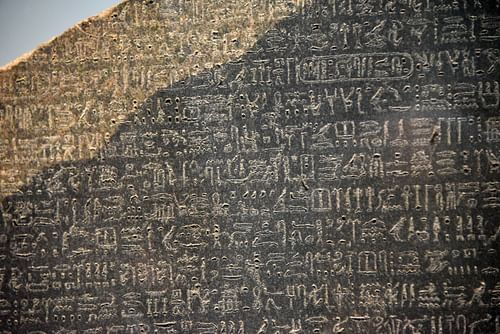ROSETTA STONE
Source: The Indian Express
1. Context
Egyptian Archaeologists have started an online campaign to demand the return of the Rosetta Stone from the British Museum, where it is the Museum's most visited exhibit.
The Campaign has gathered over 2, 500 signatures and is a part of the growing demand worldwide that western countries return artefacts of history and culture forcibly taken from the global south in the years of colonialism.
2. Rosetta Stone
- Believed to be a piece of the bigger rock, the Rosetta stone is a large slab stone with inscriptions on it.
- The inscriptions are in three scripts, conveying a decree or public message.
| This is similar to how in Ancient India, King Ashoka ordered stambhas or edicts that had messages of Buddha's teachings and news about victory in a war inscribed. |
- In the face of demands for its return, the representatives of the British Museum were told that of 28 stelae or stones with inscriptions of the same decree discovered afterwards, 21 remain in Egypt.
- But the museum's website states, the inscriptions themselves are as not important.

3. Importance
The Rosetta Stone is one of these copies, so not particularly important in its right.
The important thing for us is that the decree is inscribed three times,
- in hieroglyphs (Suitable for a Priestly decree),
- Demotic (the cursive Egyptian script used for daily purposes, meaning "language of the People") and
- Ancient Greek (the language of the administration-the rulers of Egypt at this point were Greco-Macedonian after Alexander the Great's Conquest).
- The Rosetta Stone stands out for being the discovery that helped develop the specific field of ancient Egypt studies, Egyptology.
- Before it was found, there was no knowledge of what Egyptian hieroglyphs meant and how they were translated.
- But home as the stone conveyed the same information in three languages, including Ancient Greek that was understood by scholars, information on hieroglyphics was finally within the grasp of modern historians.
4. Rosetta Stone's journey to Britain
- According to the British Museum, the engraving was done during the reign of King Ptolemy V ruled from 204-181 BC.
- This puts the stone's age at well over 2, 000 years.
- It is believed to carry messages by some priests in support of the king.
- With time the stone, among other inscriptions was displaced.
| This stone was "rediscovered" in the time of French king Napoleon Bonaparte, who launched a campaign in Egypt from 1798 to 1801 "to dominate the East Mediterranean and threaten the British hold on India". |
- While details of its discovery are vague, it is said to have been found by Napoleon's soldiers accidentally in 1799 in the city of Rashid (Called Rosetta by the French) in the Nile Delta.
- On Napoleon's defeat later at the hands of the British, the Treaty of Alexandria (1801) led to its transfer and it has been at the British Museum since then.
5. Is there a possibility of the stone's return to Egypt?
- While this current request is not backed by the government officially, such calls have been made before.
However, a few requests have been getting approved of late by Museums. - London's Horniman Museum said in August this year that it would return 72 artefacts, including the Benin Bronzes that were looted from Benin City by British Soldiers in 1897, to the Nigerian government.
- Scotland's Kelvingrove Art Gallery and Museum also signed a similar deal with India in the same month, which was " thought to be the first repatriation to India from the UK museum.
- The seven items included 14th Century carvings and 11th-century stone door jams, that were stolen from shrines and temples in the 19th century.
For Prelims & Mains
|
For Prelims: Rosetta stone, Egypt inscriptions, Napolean,
For Mains: What is Rosetta Stone and explain its importance in Egyptian art and culture (250 words)
|



